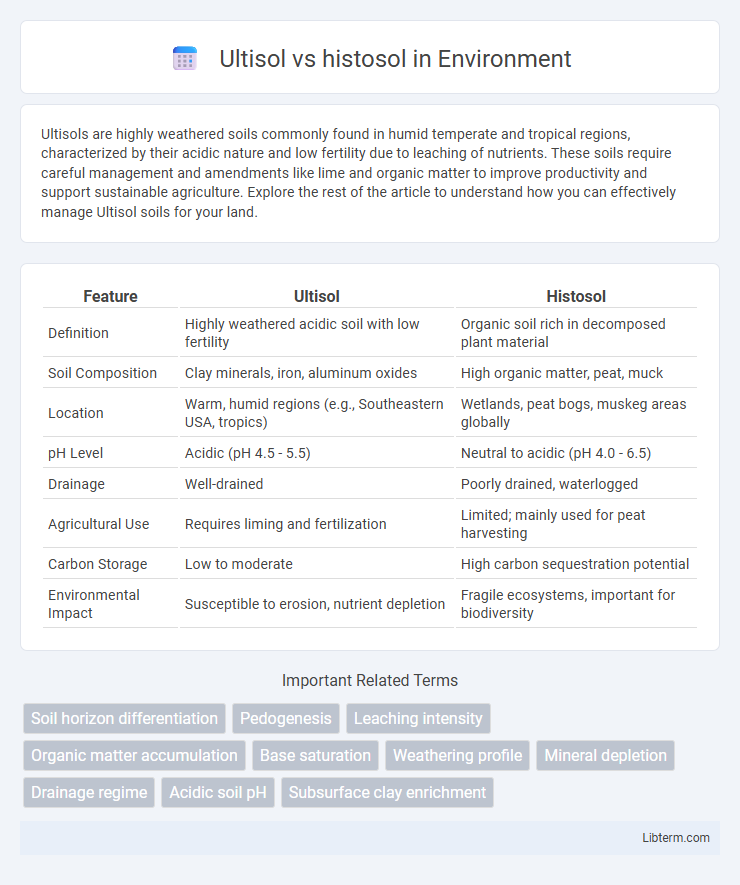Ultisols are highly weathered soils commonly found in humid temperate and tropical regions, characterized by their acidic nature and low fertility due to leaching of nutrients. These soils require careful management and amendments like lime and organic matter to improve productivity and support sustainable agriculture. Explore the rest of the article to understand how you can effectively manage Ultisol soils for your land.
Table of Comparison
| Feature | Ultisol | Histosol |
|---|---|---|
| Definition | Highly weathered acidic soil with low fertility | Organic soil rich in decomposed plant material |
| Soil Composition | Clay minerals, iron, aluminum oxides | High organic matter, peat, muck |
| Location | Warm, humid regions (e.g., Southeastern USA, tropics) | Wetlands, peat bogs, muskeg areas globally |
| pH Level | Acidic (pH 4.5 - 5.5) | Neutral to acidic (pH 4.0 - 6.5) |
| Drainage | Well-drained | Poorly drained, waterlogged |
| Agricultural Use | Requires liming and fertilization | Limited; mainly used for peat harvesting |
| Carbon Storage | Low to moderate | High carbon sequestration potential |
| Environmental Impact | Susceptible to erosion, nutrient depletion | Fragile ecosystems, important for biodiversity |
Introduction to Ultisol and Histosol
Ultisols are highly weathered soils characterized by low fertility, acidic pH, and significant leaching, commonly found in humid temperate and tropical regions. Histosols consist mainly of organic materials, formed from decayed plant matter in wet, anaerobic conditions, often in peat bogs and marshes. While Ultisols support certain forest ecosystems due to their mineral content, Histosols are crucial for wetland habitats and carbon storage due to their high organic matter.
Formation Processes of Ultisol and Histosol
Ultisols form in humid temperate or tropical regions through intense weathering and leaching of primary minerals, leading to acidic, nutrient-poor soils characterized by a subsurface accumulation of clay. Histosols develop in waterlogged environments where organic matter accumulates faster than it decomposes, resulting in peat or muck soils rich in organic carbon and with minimal mineral content. The contrasting formation processes highlight Ultisols as products of mineral weathering and clay translocation, while Histosols reflect anaerobic conditions favoring organic matter preservation.
Key Physical Characteristics
Ultisols exhibit a clay-rich subsoil with strong acidity and low natural fertility, characterized by a well-developed horizon showing significant leaching and iron oxide accumulation. Histosols consist predominantly of organic material, featuring high water retention and low bulk density due to extensive accumulation of decomposed plant matter. Ultisols typically have a granular to blocky structure, whereas Histosols are spongy or fibrous with a peat-like consistency.
Chemical Properties Comparison
Ultisols exhibit low pH values, typically acidic conditions ranging from 4.5 to 5.5, with high levels of iron and aluminum oxides contributing to strong soil acidity and low cation exchange capacity (CEC). Histosols are characterized by high organic matter content exceeding 20-30%, leading to a naturally higher pH range of 4.0 to 6.0 but with greater nutrient retention due to humus-rich composition and elevated CEC. Unlike Ultisols, Histosols contain significant amounts of partially decomposed plant material, resulting in higher base saturation and greater buffering capacity against soil acidity.
Distribution and Geographic Locations
Ultisols are predominantly found in humid temperate and tropical regions, especially in the southeastern United States, parts of Brazil, and Southeast Asia, where intense weathering has leached nutrients from the soil. Histosols occur mainly in wetlands, peatlands, and bogs across cooler climates such as Alaska, Canada, Northern Europe, and parts of Florida, characterized by accumulations of organic matter. The distinct geographic distributions reflect Ultisols' formation in well-drained upland areas and Histosols' development in saturated, anaerobic conditions.
Soil Fertility and Productivity Differences
Ultisols typically exhibit low soil fertility due to high acidity, aluminum toxicity, and nutrient leaching, which limits crop productivity without significant soil amendments like lime and fertilizers. Histosols, characterized by high organic matter content, retain moisture and nutrients effectively, supporting higher fertility and better productivity for crops adapted to wet conditions. Management practices for Ultisols involve intensive nutrient replacement, whereas Histosols require drainage control to optimize their agricultural potential.
Land Use and Management Practices
Ultisols, typically acidic and nutrient-poor soils found in humid temperate and tropical regions, require practices like liming, fertilization, and erosion control for sustainable agriculture. Histosols, composed mainly of organic material with high water retention, are best managed through drainage systems to prevent waterlogging and support crops like rice or cranberries. Effective land use on Ultisols focuses on crop rotation and conservation tillage, while Histosols demand careful hydrological management to maintain soil structure and fertility.
Environmental Significance
Ultisols play a critical role in tropical and subtropical ecosystems by supporting diverse vegetation yet are prone to nutrient depletion and erosion, impacting long-term agricultural productivity and carbon sequestration. Histosols, rich in organic matter and primarily found in wetlands, act as significant carbon sinks, aiding in climate regulation and water filtration while being vulnerable to drainage and degradation. Understanding the environmental significance of these soils highlights their contrasting roles in ecosystem services and the importance of sustainable land management practices.
Challenges in Cultivation
Ultisols present cultivation challenges due to their acidic pH, low nutrient availability, and poor water retention, which hinder crop growth without extensive soil amendments. Histosols, composed primarily of organic matter, face difficulties in drainage and are prone to subsidence and nutrient leaching, complicating long-term agricultural use. Both soil types require tailored management practices such as lime application for Ultisols and water control systems for Histosols to sustain productive cultivation.
Summary: Choosing Between Ultisol and Histosol
Ultisols are acidic, nutrient-poor soils typical of humid temperate and tropical regions, characterized by high clay content and strong weathering, making them suitable for forestry and certain crops with proper management. Histosols consist primarily of organic matter, found in wetlands and peat bogs, offering high fertility but requiring drainage for agriculture. Selecting between Ultisol and Histosol depends on land use goals, soil drainage capacity, and nutrient management strategies.
Ultisol Infographic

 libterm.com
libterm.com